锁相技术译文翻译
- 格式:doc
- 大小:47.00 KB
- 文档页数:11
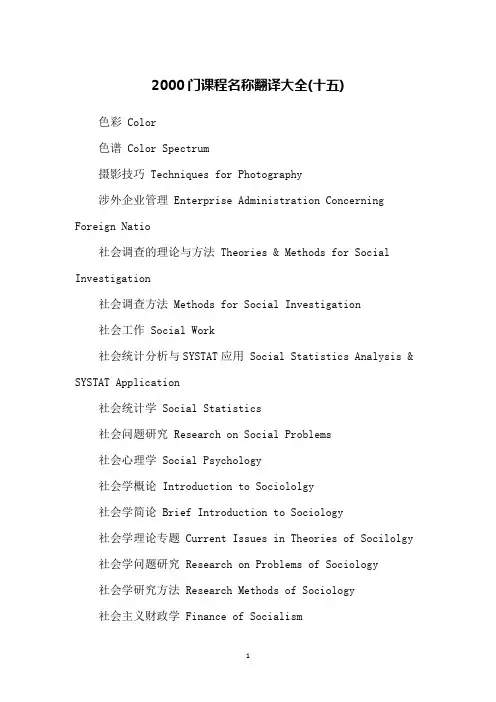
2000门课程名称翻译大全(十五)色彩 Color色谱 Color Spectrum摄影技巧 Techniques for Photography涉外企业管理 Enterprise Administration Concerning Foreign Natio社会调查的理论与方法 Theories & Methods for Social Investigation社会调查方法 Methods for Social Investigation社会工作 Social Work社会统计分析与SYSTAT应用 Social Statistics Analysis & SYSTAT Application社会统计学 Social Statistics社会问题研究 Research on Social Problems社会心理学 Social Psychology社会学概论 Introduction to Sociololgy社会学简论 Brief Introduction to Sociology社会学理论专题 Current Issues in Theories of Socilolgy 社会学问题研究 Research on Problems of Sociology社会学研究方法 Research Methods of Sociology社会主义财政学 Finance of Socialism社会主义各国政,经体制讨论 Discussion on Political & Economic Systems in Socialism审计学 Science of Auditing生产管理 Administration of Manufacturing生产过程计算机控制 Computer Control in Manufacturing Process生产过程自动化 Water-Turbine Engine生理学 Physiology生命科学与无机化学 Life Science and Inorganic Chemistry 生物工程产品 Bio-engineering Products生物工程导论 Introduction to Bio-engineering生物化学 Biochemistry生物化学工程 Biochemical Engineering生物化学及实验 Biochemistry Experiment生物检测技术 Measurement for Biotechnique生物控制论 Biocybernetics生物流变学 Biorheology生物物理 Biophysics生物学专题 Currents Issues in Biology生物医学超声学 Biomedical Supersonics失效分析 Invalidation Analysis诗歌美学 Aesthetics of Poetry时间序列 Time Sequence实变函数 Functions of Real Variable实验分析 Experimental Analysis实验力学 Experimental Mechanics实验力学基础 Basis of Experimental Mechanics实验流体 Experimental Flowing Object实验应力分析 Analysis of Experimental Stress世界近现代经济史 Modern History of World Economy世界近现代史 Modern History of the World世界文化史 History of World Culture世界政治经济与国际关系 World Politic Ecomony&International Relationship适应控制系统 Adaption Control System市场学 Science of Market市场研究 Research on Market市场预测 Market Predicting输入输出设计原理 Principle of Input and Output Designing 书法 Handwriting数据结构 Data Structure数据库概论 Introduction to Database数据库基础 Basis of Database数据库技术 Technique of Database数据库设计与分析 Design & Analysis of Database数据库系统原理 Principles of Database System数据库应用 Application of Database数据库原理及应用 Principle & Application of Database数控机床 Digit Control Machine Tool数控技术 Digit Control Technique数理方程 Mathematical Equations数理方程积分变换 Integral Transmission of Mathematical Equation数理方程与特殊函数 Equations of Mathmatical Physics & Special Functions数理逻辑 Mathematical Logic数理统计 Mathematical statistics数量经济 Quantity Economics数学分析 Mathematical Analysis数学规划 Mathematical Planning数学模型 Mathematical Modening数学物理方法 Method of Mathematical Physics数值电路 Digital Circuit数值分析 Numerical Analysis数值计算 Digital Computation数字测量技术 Digital Measuring Technique数字测量实验技术 Experimental Technique of Digital Measuring数字测试实验技术 Experimental Technique of Digital Testing数字电路 Digital Circuit数字电路及微机原理 Digital Circuit & Computer Principles 数字电视 Digital Television数字电子基础 Fundamental Digital Electionics数字电子技术 Digital Electronic Technique数字电子技术基础 Fundamental Digital Electronic Technique数字电子技术设计与实验 Experiment & Design of Digital Electron Technique数字电子线路 Digital Electrical Circuitry数字电子与微机原理 Digital Electronics & Principle of Microcomputer数字仿真 Digital Simulation数字化测量技术 Digital Measuring Technique数字控制及微机控制技术 Digital Control & Microcomputer Control Technique数字逻辑 Digital Logic数字图象处理 Digital Image Processing数字系统逻辑设计 Logical Design of Digital System数字系统设计 Design of Digital System数字信号处理 Digital Signal Processing双曲线方程 Hyperbolic Equation水电能源学 Science of HydrOelectric Enelgy水电站过渡过程的特殊问题 Special Problems in the Transition of a Hydropower Station水电站计算机控制 Computer Control in Hydropower Station 水电站经济运行 Economic Operation in Hydropower Station 水电站控制系统分析 Analysis of Control System in Hydropower Station水电站自动化 Automation of Hydropower Station水动力学 Water Dynamics水机工艺结构分析 Technics Structure Analysis of Hydraulic Machinery水力机械测试技术 Test Technique of Hydraulic Machinery 水力机械的汽蚀 Gas Etching of Hydraulic Machinery水力机械调节 Adjustment of Hydraulic Machinery水力机械强度计算 Intensity Calculation of Hydraulic Machinery水力机械原理 Principles of Hydraulic Machinery水力机械制造工艺及结构分析 Manufacturing Technique &Structure Analysis of Hydraulic Machinery水力机械制造工艺学 Manufacturing Technique for Hydraulic Machinery水力学 Hydraulics水轮机 Water-Turbine Engine水轮机调节 Water-Turbine Engine Adaption水轮机调节系统 Adaptive System of Water-Turbine Engine 水轮机水力设计 Hydraulic Design of Water Engine水轮机原理及水力设计 Principles of Water-Turbine Engine & Design of Water Engine水轮机原理与CAD Principle of Water-Turbine Engine & CAD 水轮水力设计 Hydraulic Design of Water Engine水现代控制理论 Modern Theory of Water Controling水质稳定技术 Stability Technique of Water Quality思想教育 Virtue Education素描 Pencil Sketch速冻技术 Technique of Speed Freezing塑性力学 Plastic Machanics算法语言 Algorithmic Language随机过程 Stochastic Process & Time Series Analysis随机运筹学 Randomized Operational Research锁相技术 Phase Lock Technique---来源网络整理,仅供参考。
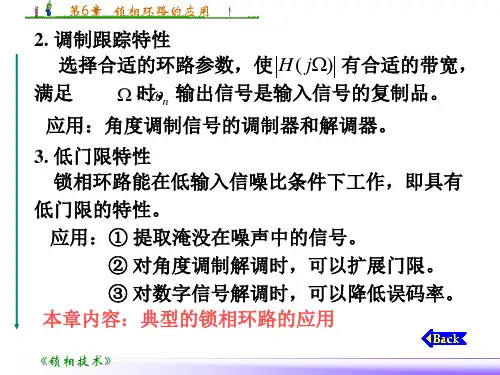
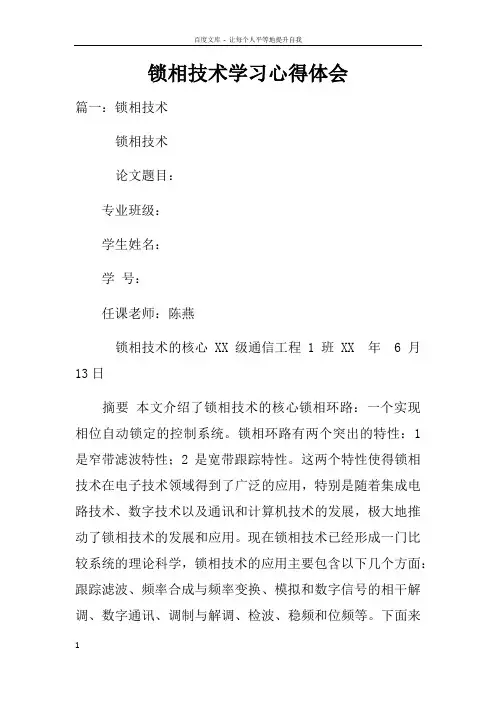
锁相技术学习心得体会篇一:锁相技术锁相技术论文题目:专业班级:学生姓名:学号:任课老师:陈燕锁相技术的核心 XX级通信工程1班 XX 年 6 月13日摘要本文介绍了锁相技术的核心锁相环路:一个实现相位自动锁定的控制系统。
锁相环路有两个突出的特性:1是窄带滤波特性;2是宽带跟踪特性。
这两个特性使得锁相技术在电子技术领域得到了广泛的应用,特别是随着集成电路技术、数字技术以及通讯和计算机技术的发展,极大地推动了锁相技术的发展和应用。
现在锁相技术已经形成一门比较系统的理论科学,锁相技术的应用主要包含以下几个方面:跟踪滤波、频率合成与频率变换、模拟和数字信号的相干解调、数字通讯、调制与解调、检波、稳频和位频等。
下面来主要介绍一下锁相技术的核心,掌握核心就能运用得当。
关键字:核心,锁相环路,运用锁相环路的工作原理:锁相环路是一种反馈电路,锁相环的英文全称是Phase-Locked Loop,简称PLL。
其作用是使得电路上的时钟和某一外部时钟的相位同步。
因锁相环可以实现输出信号频率对输入信号频率的自动跟踪,所以锁相环通常用于闭环跟踪电路。
锁相环在工作的过程中,当输出信号的频率与输入信号的频率相等时,输出电压与输入电压保持固定的相位差值,即输出电压与输入电压的相位被锁住,这就是锁相环名称的由来。
在数据采集系统中,锁相环是一种非常有用的同步技术,因为通过锁相环,可以使得不同的数据采集板卡共享同一个采样时钟。
因此,所有板卡上各自的本地 80MHz和20MHz 时基的相位都是同步的,从而采样时钟也是同步的。
因为每块板卡的采样时钟都是同步的,所以都能严格地在同一时刻进行数据采集。
锁相环路是一个相位反馈自动控制系统。
它由以下三个基本部件组成:鉴相器(PD)、环路滤波器(LPF)和压控振荡器(VCO)。
锁相环的工作原理:1. 压控振荡器的输出经过采集并分频;2. 和基准信号同时输入鉴相器;3. 鉴相器通过比较上述两个信号的频率差,然后输出一个直流脉冲电压;4. 控制VCO,使它的频率改变;5. 这样经过一个很短的时间,VCO 的输出就会稳定于某一期望值。
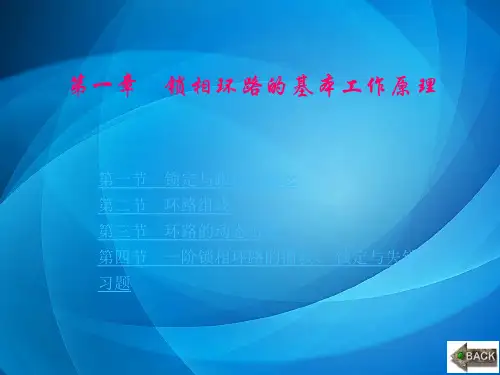
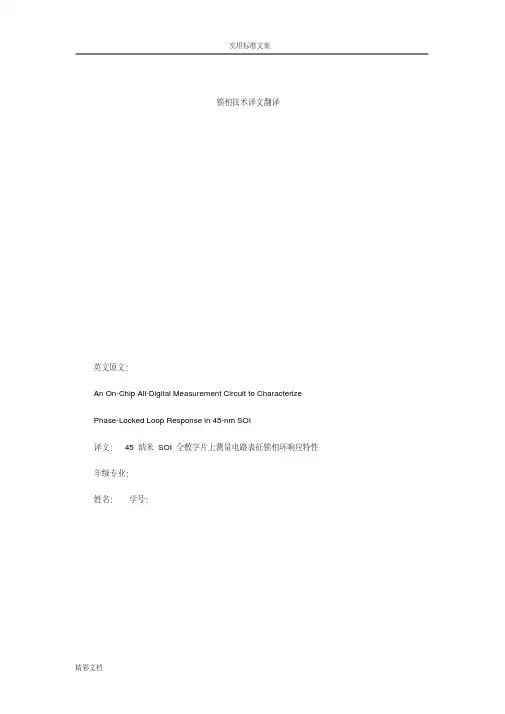
锁相技术译文翻译英文原文:An On-Chip All-Digital Measurement Circuit to Characterize Phase-Locked Loop Response in 45-nm SOI译文:45纳米SOI全数字片上测量电路表征锁相环响应特性年级专业:姓名:学号:2013 年 6 月 2 日英文中文An On-Chip All-Digital Measurement Circuit to Characterize Phase-Locked Loop Response in 45-nm SOIAbstract—An all-digital measurement Circuit , built in 45-nm SOI-CMOS enabl es on-chip characterization of phase-loc ked loop (PLL) response to a self-induce d phase step.This technique allows estimationof PLL closed-loop bandwidth and jitterpeaking. The circuit canbe used to plot step-response vs.time, measure static phase error,and observe phase-lock status. INTRODUCTIONMany applications such as PCI Express ? require a PLL to produce alow-jitter cl ock at a given frequency while meeting stringent bandwidth and jitter peaking r 45纳米SOI全数字片上测量电路表征锁相环响应特性摘要---建立在45纳米的SOI-CMOS上一个全数字测量电路,它能够表征PLL对自诱导相步进的响应这项技术允许对PLL闭环带宽和抖动峰值的估计。
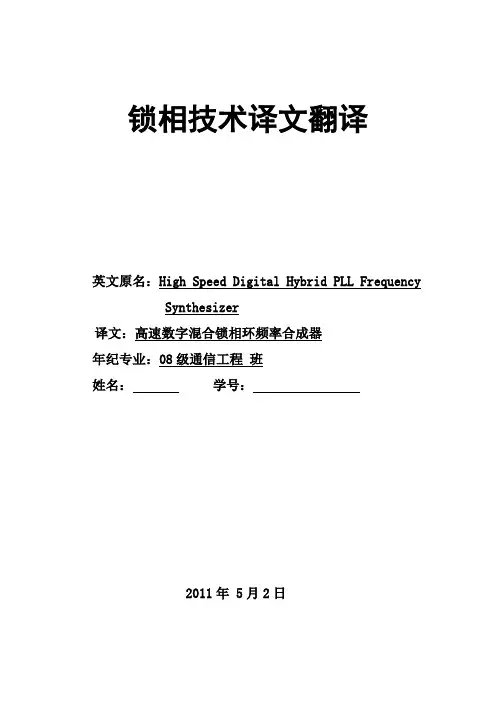
锁相技术译文翻译英文原名:High Speed Digital Hybrid PLL Frequency Synthesizer译文:高速数字混合锁相环频率合成器年纪专业:08级通信工程班姓名:学号:2011年 5月2日To get the high-speed, it is necessary to prepare the precise synchronization of the complicated design.In 2001, H. G. Ryu proposed a simplified structure of the DDFS (direct digital frequency synthesizer)-driven PLL for the high switching speed [2].However, there is a problem that the speed of the whole system is limited by PLL.Y. Fouzar proposed a PLL frequency synthesizer of dual loop configuration using frequency-to-voltage converter (FVC) [3].It has a fast switching speed by the PD (phase detector), FVC using output signal of VCO and the proposed coarse tuning controller.However, H/W complexity is increased for the high switching speed.Also, it shows the fast switching characteristic only when the FVC works well.Another method is pre-tuning one which is called DH-PLL in this study [4].It has very high speed switching property, but H/W complexity and power consumption are increased due to digital look-up table (DLT) which is usually implemented by the ROM including the transfer characteristic ofVCO(voltage controlled oscillator).For this reason, this paper proposes a timing synchronization circuit for the rapid frequency synthesis and a very simple DLT replacement digital logic block instead of the complex ROM type DLT for high speed switching and low power consumption. Also, the requisite condition is solved in the proposed method. The fast switching operation at every the frequency synthesis process is verified by the computer circuit simulation.II.DH-PLL synthesizerAs shown in Fig.1, the open-loop synthesizer is a direct frequency synthesis type that VCO 要得到高运行速度,事先做好复杂设计的精确同步是必要的。
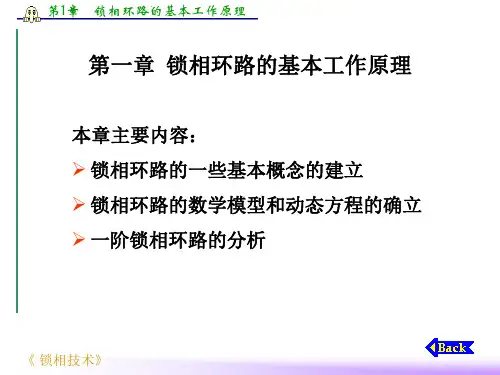
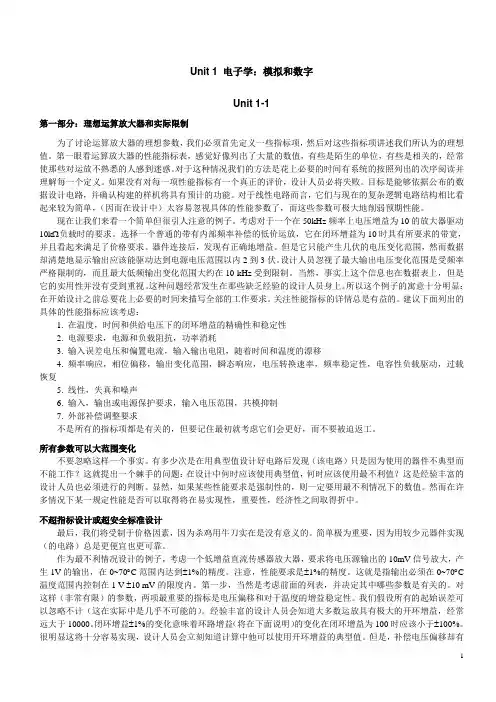
Unit 1 电子学:模拟和数字Unit 1-1第一部分:理想运算放大器和实际限制为了讨论运算放大器的理想参数,我们必须首先定义一些指标项,然后对这些指标项讲述我们所认为的理想值。
第一眼看运算放大器的性能指标表,感觉好像列出了大量的数值,有些是陌生的单位,有些是相关的,经常使那些对运放不熟悉的人感到迷惑。
对于这种情况我们的方法是花上必要的时间有系统的按照列出的次序阅读并理解每一个定义。
如果没有对每一项性能指标有一个真正的评价,设计人员必将失败。
目标是能够依据公布的数据设计电路,并确认构建的样机将具有预计的功能。
对于线性电路而言,它们与现在的复杂逻辑电路结构相比看起来较为简单,(因而在设计中)太容易忽视具体的性能参数了,而这些参数可极大地削弱预期性能。
现在让我们来看一个简单但很引人注意的例子。
考虑对于一个在50kHz频率上电压增益为10的放大器驱动10kΩ负载时的要求。
选择一个普通的带有内部频率补偿的低价运放,它在闭环增益为10时具有所要求的带宽,并且看起来满足了价格要求。
器件连接后,发现有正确地增益。
但是它只能产生几伏的电压变化范围,然而数据却清楚地显示输出应该能驱动达到电源电压范围以内2到3伏。
设计人员忽视了最大输出电压变化范围是受频率严格限制的,而且最大低频输出变化范围大约在10 kHz受到限制。
当然,事实上这个信息也在数据表上,但是它的实用性并没有受到重视。
这种问题经常发生在那些缺乏经验的设计人员身上。
所以这个例子的寓意十分明显:在开始设计之前总要花上必要的时间来描写全部的工作要求。
关注性能指标的详情总是有益的。
建议下面列出的具体的性能指标应该考虑:1. 在温度,时间和供给电压下的闭环增益的精确性和稳定性2. 电源要求,电源和负载阻抗,功率消耗3. 输入误差电压和偏置电流,输入输出电阻,随着时间和温度的漂移4. 频率响应,相位偏移,输出变化范围,瞬态响应,电压转换速率,频率稳定性,电容性负载驱动,过载恢复5. 线性,失真和噪声6. 输入,输出或电源保护要求,输入电压范围,共模抑制7. 外部补偿调整要求不是所有的指标项都是有关的,但要记住最初就考虑它们会更好,而不要被迫返工。
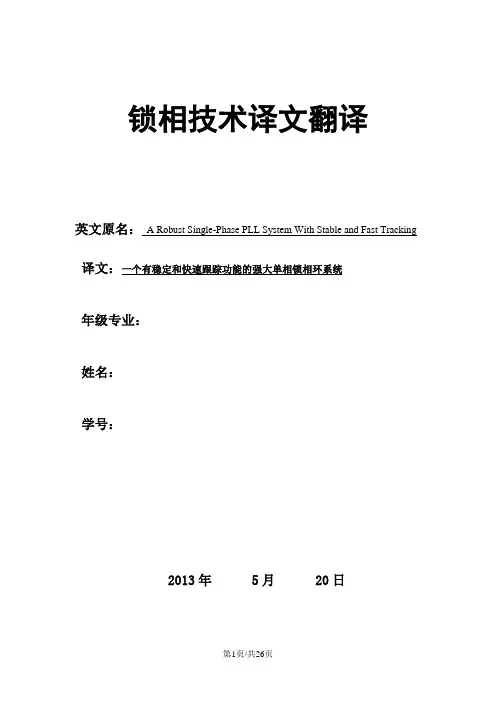
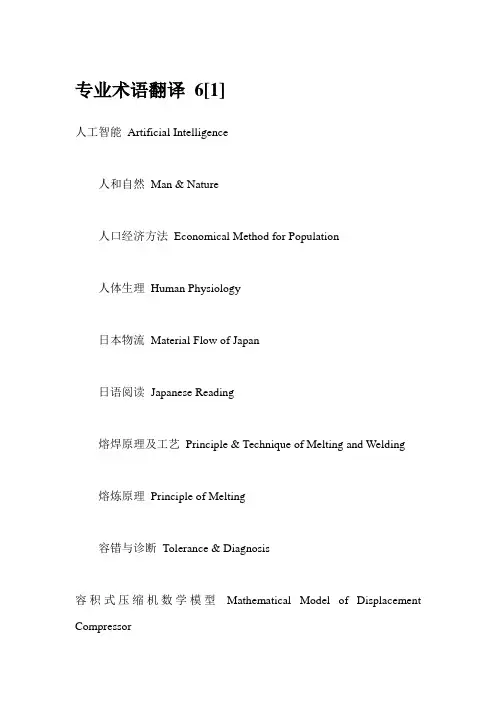
专业术语翻译6[1]人工智能Artificial Intelligence人和自然Man & Nature人口经济方法Economical Method for Population人体生理Human Physiology日本物流Material Flow of Japan日语阅读Japanese Reading熔焊原理及工艺Principle & Technique of Melting and Welding熔炼原理Principle of Melting容错与诊断Tolerance & Diagnosis容积式压缩机数学模型Mathematical Model of Displacement Compressor软件工程Software Engineering软件技术基础Basis of Software Technique软件开发工具与环境Tools & Environment for Software Developing弱信号检测Testing of Feeble Signals色彩Color色谱Color Spectrum摄影技巧Techniques for Photography涉外企业管理Enterprise Administration Concerning Foreign Natio社会调查的理论与方法Theories & Methods for Social Investigation社会调查方法Methods for Social Investigation社会工作Social Work社会统计分析与SYSTAT应用Social Statistics Analysis & SYSTAT Application社会统计学Social Statistics社会问题研究Research on Social Problems社会心理学Social Psychology社会学概论Introduction to Sociololgy社会学简论Brief Introduction to Sociology社会学理论专题Current Issues in Theories of Socilolgy社会学问题研究Research on Problems of Sociology社会学研究方法Research Methods of Sociology社会主义财政学Finance of Socialism社会主义各国政,经体制讨论Discussion on Political & Economic Systems in Socialism审计学Science of Auditing生产管理Administration of Manufacturing生产过程计算机控制Computer Control in Manufacturing Process生产过程自动化Water-Turbine Engine生理学Physiology生命科学与无机化学Life Science and Inorganic Chemistry生物工程产品Bio-engineering Products生物工程导论Introduction to Bio-engineering生物化学Biochemistry生物化学工程Biochemical Engineering生物化学及实验Biochemistry Experiment生物检测技术Measurement for Biotechnique 生物控制论Biocybernetics生物流变学Biorheology生物物理Biophysi生物学专题Currents Issues in Biology生物医学超声学Biomedical Supersonics失效分析Invalidation Analysis诗歌美学Aesthetics of Poetry时间序列Time Sequence实变函数Functions of Real Variable实验分析Experimental Analysis实验力学Experimental Mechanics实验力学基础Basis of Experimental Mechanics实验流体Experimental Flowing Object实验应力分析Analysis of Experimental Stress世界近现代经济史Modern History of World Economy世界近现代史Modern History of the World世界文化史History of World Culture世界政治经济与国际关系World Politic Ecomony &International Relationship适应控制系统Adaption Control System市场学Science of Market市场研究Research on Market市场预测Market Predicting输入输出设计原理Principle of Input and Output Designing 书法Handwriting数据结构Data Structure数据库概论Introduction to Database数据库基础Basis of Database数据库技术Technique of Database数据库设计与分析Design & Analysis of Database数据库系统原理Principles of Database System数据库应用Application of Database数据库原理及应用Principle & Application of Database数控机床Digit Control Machine Tool数控技术Digit Control Technique数理方程Mathematical Equations数理方程积分变换Integral Transmission of Mathematical Equation数理方程与特殊函数Equations of Mathmatical Physics & Special Functions数理逻辑Mathematical Logic数理统计Mathematical statistics数量经济Quantity Economics数学分析Mathematical Analysis数学规划Mathematical Planning数学模型Mathematical Modening数学物理方法Method of Mathematical Physics数值电路Digital Circuit数值分析Numerical Analysis数值计算Digital Computation数字测量技术Digital Measuring Technique数字测量实验技术Experimental Technique of Digital Measuring 数字测试实验技术Experimental Technique of Digital Testing数字电路Digital Circuit数字电路及微机原理Digital Circuit & Computer Principles数字电视Digital Television数字电子基础Fundamental Digital Electionics数字电子技术Digital Electronic Technique数字电子技术基础Fundamental Digital Electronic Technique数字电子技术设计与实验Experiment & Design of Digital Electron Technique数字电子线路Digital Electrical Circuitry数字电子与微机原理Digital Electronics & Principle of Microcomputer数字仿真Digital Simulation数字化测量技术Digital Measuring Technique数字控制及微机控制技术Digital Control & Microcomputer Control Technique数字逻辑Digital Logic数字图象处理Digital Image Processing数字系统逻辑设计Logical Design of Digital System数字系统设计Design of Digital System数字信号处理Digital Signal Processing双曲线方程Hyperbolic Equation水电能源学Science of HydrOelectric Enelgy水电站过渡过程的特殊问题Special Problems in the Transition ofa Hydropower Station水电站计算机控制Computer Control in Hydropower Station水电站经济运行Economic Operation in Hydropower Station水电站控制系统分析Analysis of Control System in Hydropower Station水电站自动化Automation of Hydropower Station水动力学Water Dynamics水机工艺结构分析Technics Structure Analysis of Hydraulic Machinery水力机械测试技术Test Technique of Hydraulic Machinery水力机械的汽蚀Gas Etching of Hydraulic Machinery水力机械调节Adjustment of Hydraulic Machinery水力机械强度计算Intensity Calculation of Hydraulic Machinery水力机械原理Principles of Hydraulic Machinery水力机械制造工艺及结构分析Manufacturing Technique & Structure Analysis of Hydraulic Machinery水力机械制造工艺学Manufacturing Technique for Hydraulic Machinery水力学Hydraulics水轮机Water-Turbine Engine水轮机调节Water-Turbine Engine Adaption水轮机调节系统Adaptive System of Water-Turbine Engine水轮机水力设计Hydraulic Design of Water Engine水轮机原理及水力设计Principles of Water-Turbine Engine & Design of Water Engine水轮机原理与CAD Principle of Water-Turbine Engine & CAD水轮水力设计Hydraulic Design of Water Engine水现代控制理论Modern Theory of Water Controling 水质稳定技术Stability Technique of Water Quality思想教育Virtue Education素描Pencil Sketch速冻技术Technique of Speed Freezing塑性力学Plastic Machanics算法语言Algorithmic Language随机过程Stochastic Process & Time Series Analysis 随机运筹学Randomized Operational Research锁相技术Phase Lock Technique谈判技巧Negotiation Skills唐宋诗词Poetry & Prose of Tang & Song Dynasties 陶瓷材料学Science of Ceramic Material陶瓷工艺原理Principle of Pottery Technology特种泵Special Pump特种加工工艺Special Working Technology特种压缩机Special Compressor特种铸铁Special Casting Iron特种铸造Special Processes of Metal Castings体育Physical Education天线原理Principle of Antenna铁磁学Ferromagnetics铁电半导体Ferro-Electric Semiconductor铁电材料与器件Ferro-Electric Material and Element铁电压电材料与器件Ferro-V oltage Electric Material and Element 铁氧体材料Ferrite Material听说训练Practice on Listening & Speaking通风机Ventilator通信电子线路Electronic Circuit of Communication通信原理Principle of Communication通讯写作专题Current Issues on Report Writing同步控制原理Principle of Synchronic Control统计Statistics统计计算Experiment of Applied Physics统计检查与质量控制Statistic Check and Quality Control统计物理Statistical Physics统计信号分析Analysis of Statistical Signal统计学Statistics统计学原理Principle of Statistics统计学原理与工业统计Principle of Statistics & Industrial Statistics统计原理Statistics投入产出分析Analysis of Input and Output投入产出技术Input and Output Technique透平机械三元流动Three-dimensional Flow of Turbine Machinery 透平膨胀机Turbine Expansion Engine透平式压缩机特性模拟Analog of Performance ofTurbine Compressor透平压缩机强度Tensile of Turbine Compressor图论Graph Theory图论算法Algorithm on Graph Theory图论与组合Graphing & Grouping图论与组合优化Graphing & Optimal Grouping土力学与地基Soil Mechanics and Foundations托福测试Test of English as a Foreign Language拓朴学Topology外部设备讲座Lectures on Peripherial Equipment外部设备维修Repairment of Peripheral Equipment外国古代建筑史History of Western Ancient Architecture外国文献阅读Readings of Foreign Literature外国文学史History of Foreign Literature外国文学作品选译Selected Translations of Foreign Literary Works外国物流Foreign Material Flow外国物资管理Overseas Material Management外国新闻事业史History of Overseas Journalism外贸会计Foreign Business Accountancy外贸英语Foreign Business English外设概论Introduction to Peripheral Equipment外设实验Experiment on Peripheral Equipment往复泵及其它类型泵Reciprocating Pump & Other type Pumps 微波测量技术Microwave Measurement Technique微波电路计算机辅助设计CAD of Microwave Circuit微波技术Microwave Technique微波技术基础Basis of Microwave Technique微波技术与天线Microwave Technique and Antenna 微波器件Microwave Device微波器件及电路Microwave Device and Circuitry 微波铁氧体器件Microwave Iron Oxide Elements 微波网络Microwave Net。
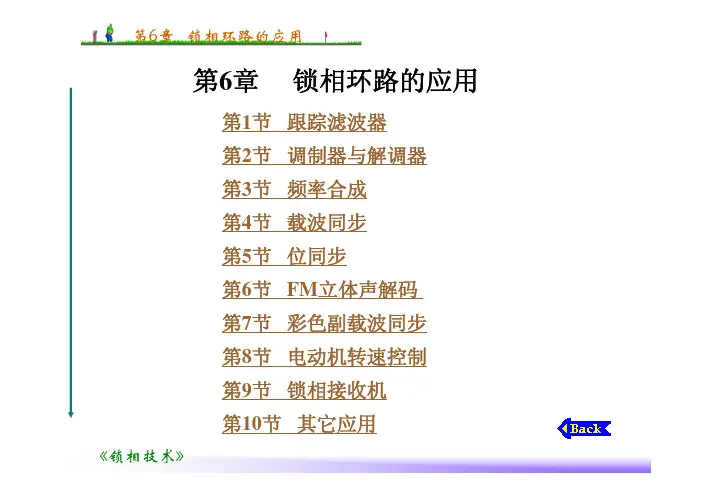
外文资料Phase-locked loop Technology :A phase-locked loop or phase lock loop (PLL) is a control system that generates a signal that has a fixed relation to the phase of a "reference" signal. A phase-locked loop circuit responds to both the frequency and the phase of the input signals, automatically raising or lowering the frequency of a controlled oscillator until it is matched to the reference in both frequency and phase. A phase-locked loop is an example of a control system using negative feedback. In the order of the PLL is the way of made the frequency stability in the send up wireless,include VCO and PLL integrated circuits,VCO send up a signal,some of the signal is output,and the other through the frequency division with PLL integrated circuits generate the local signal making compared.In the order to remain the same,it’s must be remain the phase displacement same.If the phase displacement have some changes,the output of the PLL integrated circuits have some changes too,to controlle VCO until phase diffe rence to restore,make both cotrolled oscillator’s frequency and phase with input signal which is close-loop electronic circuit keep firm relationship.Phase-locked loops are widely used in radio, telecommunications, computers and other electronic applications. They may generate stable frequencies, recover a signal from a noisy communication channel, or distribute clock timing pulses in digital logic designs such as microprocessors. Since a single integrated circuit can provide a complete phase-locked-loop building block, the technique is widely used in modern electronic devices, with output frequencies from a fraction of a cycle per second up to many gigahertz.Earliest research towards what became known as the phase-locked loop goes back to 1932, when British researchers developed an alternative to Edwin Armstrong's superheterodyne receiver, the Homodyne. In the homodyne or synchrodyne system, a local oscillator was tuned to the desired input frequency and multiplied with the input signal. The resulting output signal included the original audio modulation information.The intent was to develop an alternative receiver circuit that required fewer tuned circuits than the superheterodyne receiver. Since the local oscillator would rapidly drift in frequency, an automatic correction signal was applied to the oscillator, maintaining it in the same phase and frequency as the desired signal. The technique was described in 1932, in a paper by H.de Bellescise, in the French journal Onde Electrique.In analog television receivers since at least the late 1930s, phase-locked-loop horizontal and vertical sweep circuits are locked to synchronization pulses in the broadcast signal. When Signetics introduced a line of monolithic integrated circuits that were complete phase-locked loop systems on a chip in 1969, applications for the technique multiplied. A few years later RCA introduced the "CD4046" CMOS Micropower Phase-Locked Loop, which became a popular integrated circuit. Applications:Phase-locked loops are widely used for synchronization purposes; in space communications for coherent carrier tracking and threshold extension, bit synchronization, and symbol synchronization. Phase-locked loops can also be used to demodulate frequency-modulated signals. In radio transmitters, a PLL is used to synthesize new frequencies which are a multiple of a reference frequency, with the same stability as the reference frequency.Clock recovery :Some data streams, especially high-speed serial data streams (such as the raw stream of data from the magnetic head of a disk drive), are sent without an accompanying clock. The receiver generates a clock from an approximate frequency reference, and then phase-aligns to the transitions in the data stream with a PLL. This process is referred to as clock recovery. In order for this scheme to work, the data stream must have a transition frequently enough to correct any drift in the PLL's oscillator. Typically, some sort of redundant encoding is used; 8B10B is very common.Deskewing :If a clock is sent in parallel with data, that clock can be used to sample the data.Because the clock must be received and amplified before it can drive the flip-flops which sample the data, there will be a finite, and process-, temperature-, and voltage-dependent delay between the detected clock edge and the received data window. This delay limits the frequency at which data can be sent. One way of eliminating this delay is to include a deskew PLL on the receive side, so that the clock at each data flip-flop is phase-matched to the received clock. In that type of application, a special form of a PLL called a Delay-Locked Loop (DLL) is frequently used.Clock generation:Many electronic systems include processors of various sorts that operate at hundreds of megahertz. Typically, the clocks supplied to these processors come from clock generator PLLs, which multiply a lower-frequency reference clock (usually 50 or 100 MHz) up to the operating frequency of the processor. The multiplication factor can be quite large in cases where the operating frequency is multiple gigahertz and the reference crystal is just tens or hundreds of megahertz.Spread spectrum:All electronic systems emit some unwanted radio frequency energy. Various regulatory agencies (such as the FCC in the United States) put limits on the emitted energy and any interference caused by it. The emitted noise generally appears at sharp spectral peaks (usually at the operating frequency of the device, and a few harmonics).A system designer can use a spread-spectrum PLL to reduce interference with high-Q receivers by spreading the energy over a larger portion of the spectrum. For example, by changing the operating frequency up and down by a small amount (about 1%), a device running at hundreds of megahertz can spread its interference evenly over a few megahertz of spectrum, which drastically reduces the amount of noise seen by FM receivers which have a bandwidth of tens of kilohertz.中文翻译锁相环技术:锁相环或锁相回路(PLL)是一个信号控制系统,即用来锁定一系列的“参考”信号。
<<频率合成技术>>报告**:***学号:***************:***报告要求:1、锁相技术的发展历史2、频率合成技术的应用3、设计锁相电路一、锁相技术的发展历史频率源是现代电子系统的重要组成部分,被称为许多电子系统的“心脏”。
在通信、雷达和导航等设备中,它既是发射机的激励信号源,又是接收机的本地振荡器;在电子对抗设备中,它可以作为干扰信号发生器;在测试设备中,它可以作为标准信号源。
随着现代电工电子技术的不断发展,人们对频率源的要求越来越高。
性能卓越的频率源均通过频率合成技术来实现。
频率合成技术,就是将一个(或多个)基准频率变换成一个(或多个)合乎质量要求的所需频率的技术。
频率合成技术的理论形成于二十世纪三十年代左右,到现在大概经历了三代的发展过程。
1、第一代一直接模拟频率合成(DAFS)技术直接模拟频率合成(Direct Analog Frequency Synthesis)技术是一种早期的频率合成技术,原理简单,易于实现。
它由模拟振荡器产生参考频率源,再经谐波发生器产生一系列谐波,然后经混频、分频和滤波等处理产生大量的离散频率。
根据所使用的参考频率的数目不同可分为非相关合成方法和相关合成方法两种类型。
非相关合成方法使用多个晶体参考频率源,所需的各种频率分别由这些参考源提供。
它的缺点在于制作具有相同频率稳定性和精度的多个晶体参考频率源既复杂又困难,而且成本很高。
相关合成方法只是用一个晶体参考频率源,所需的各种频率都由它经过分频、混频和倍频后得到,因而合成器输出频率的稳定性和精度与参考源一样。
直接模拟频率合成方法的优点是频率转换时间短、相位噪声低,但由于采用大量的混频、分频、倍频和滤波等模拟硬件设备,使频率合成器的体积大、成本高、结构复杂、容易产生杂散分量,大多数硬件的非线性影响难于抑制。
2、第二代——基于锁相环(PLL)的间接频率合成技术锁相环是间接频率合成技术中的一个关键部分,它是一个负反馈环路,是一个实现相位自动锁定的控制系统,其输出信号与参考信号相位同步,简称PLL(Phase Locked Loop)。
锁相技术期末总结一、引言锁相技术是一种广泛应用于现代电子技术中的信号处理方法,主要用于提取信号中的相位信息。
它通过对输入信号与本地参考信号进行比较和修正,实现对信号相位的精确测量和调整。
锁相技术的应用领域非常广泛,包括无线通信、激光测距、声纳系统、医学影像等。
在本次课程学习中,我们深入了解了锁相技术的原理、应用和实现方法,并通过实践操作进一步巩固了对锁相技术的理解。
二、锁相技术的原理和基本概念锁相技术的原理是基于反馈控制和频率调制的,通过频率调制输入信号和本地参考信号,实现对信号相位的精确测量和调整。
1. 相位差测量原理通过将输入信号与本地参考信号进行乘法运算,并通过低通滤波器和放大器对乘积信号进行处理,最终得到与相位差成正比的直流电压。
根据这个原理,我们可以通过测量这个直流电压来得到输入信号与参考信号之间的相位差。
2. 锁相循环原理锁相循环是指通过反馈控制将输入信号的相位差调整到指定值的过程。
锁相循环由相位比较器、环路滤波器、VCO(Voltage Controlled Oscillator)和反馈网络等组成。
相位比较器用于比较输入信号的相位差和参考信号的相位差,输出误差信号;环路滤波器用于对误差信号进行滤波;VCO用于将滤波后的误差信号转换成频率信号,并与参考信号进行混频;反馈网络将VCO的输出作为参考信号送回相位比较器,形成一个闭环控制系统。
三、锁相技术的应用锁相技术在各个领域中都有广泛的应用,下面主要介绍其中几个典型的应用。
1. 通信领域锁相技术在通信领域中的应用主要包括载波恢复、时钟恢复和时钟同步。
在接收端,通过锁相环的频率跟踪功能可以自适应地追踪和调整接收信号的频率,从而实现载波恢复。
而由于通信系统中的时钟信号也是通过调制到信号中进行传输的,因此通过锁相循环也可以实现对时钟信号的恢复和同步。
2. 激光测距锁相技术在激光测距领域中被广泛应用。
激光测距的原理是利用激光光束射到目标上并接收反射光,通过测量光传播的时间来计算目标的距离。
第五章集成锁相环锁相技术可广泛用于广播电视、雷达通信、频率合成、信号自动跟踪、自动控制、FM 解调、电机稳速、抑制电网干扰、时钟同步等领域。
本章首先介绍锁相环的基本概念,然后重点阐述CMOS集成锁相环CD4046的工作原理与应用技术。
第一节锁相环简介众所周知,如果广播电台发射的信号频率不稳定,或者超外差式收音机的本级振荡频率不稳定,在收听节目时就很容易发生“跑台”、“串台”现象,严重影响收听效果。
假设收音机具有自动跟踪电台的本领,能根据电台频率的变化随时调整本振频率,确保465kHz的差频不变,则上述问题可迎刃而解。
而这正是锁相环的用途之一。
目前,在现代通信设备、彩色电视机、高档收录机中,广泛采用了锁相技术。
所谓锁相,就是实现相位同步。
能使两个电信号的相位保持同步的闭环系统叫锁相环(PLL)。
锁相环主要包括四部分:相位比较器(PD亦称鉴相器),低通滤波器(LPF);压控振荡器(VCO);负反馈电路(运算器)。
锁相环属于闭环控制系统,其基本构成如图5-1所示。
使用锁相环时一般要在负反馈线路中插入一个运算器:除法器(÷N)、乘法器(×N图5-1 锁相环的基本构成)、加法器(+N)或减法器(-N)。
若令锁相环的输出频率f2分别为N f1、f1/N、f1+N、f1-N,则运算器的输出频率f2'依次对应于f2/N、Nf2、f2-N、f2+N。
压控振荡器的输出信号为U O(t),运算器的输出信号为U'O(t)。
相位比较器一端接输入信号U I(t),另一端接比较信号U'O(t)。
比较器将U I(t)与U'O(t)的相位进行比较,产生一个与二者的相位差△Φ成正比的误差电压UΦ(t)。
UΦ(t)再经过低通滤波器滤除高频分量,得到平均值电压即控制电压U d(t),加到VCO的控制端,使之振荡频率改变,进而使f2'向输入信号频率f1靠拢,二者频率差迅速减小,直至△f=0,f2'=f1。